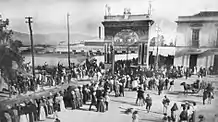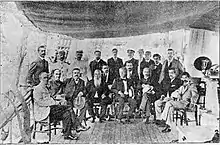| Totoposte Wars | |||||||
|---|---|---|---|---|---|---|---|
 Guatemalan soldiers in Guatemala City in 1903. | |||||||
| |||||||
| Belligerents | |||||||
|
| ||||||
|
| ||||||
|
| ||||||
| Commanders and leaders | |||||||
|
| ||||||
|
| ||||||
|
| ||||||
| Strength | |||||||
| Unknown | 55,000 | ||||||
The Totoposte Wars were three military conflicts fought in Central America between 1890 and 1906. The First Totoposte War occurred during the presidency of Manuel Lisandro Barillas Bercián in Guatemala, after the overthrow of Salvadoran President Francisco Menéndez by General Carlos Ezeta in El Salvador, which caused the exile of many Salvadorans who took refuge in Guatemala and who requested the help of President Barillas Bercián to stop the armies of Ezeta. The Second Totoposte War arose after the opposition of Guatemalan President Manuel Estrada Cabrera to the integration of Guatemala with the Greater Republic of Central America since Estrada Cabrera was more inclined to work with the government of the United States.[1] The Third Totoposte War occurred in 1906 in similar conditions. In all three wars, the Guatemalan people mockingly referred to the war as the "Totoposte War" because it only served to consume large amounts of this corn-based food, without actually fighting.[2]
Background, 1890
On June 22, 1890, Salvadoran president Francisco Menéndez was overthrown by General Carlos Ezeta.[3] As a result, many officials with ties to the previous administration fled the country to Guatemala. The officials made a request to Guatemalan President Manuel Lisandro Barillas Bercián to invade El Salvador and depose Ezeta, alleging that he was planning an invasion of Guatemala. The claims were false as the officials wanted to regain power, but Barillas Bercián believed the claims and made a decree declaring war on El Salvador on June 27, 1890.[2][4]
First War
Guatemalan soldiers were mobilized to the border with El Salvador. Camilo Álvarez, a Salvadoran exile, was one of the army's commanders. The Guatemalan soldiers halted their advance when they arrived at the border. Meanwhile, Ezeta's army was busy crushing a rebellion in San Salvador, the nation's capital. After months of no combat and effective stalemate, diplomats signed a peace treaty on August 21, 1890.[2][5][6]
Guatemalans called this the "Totoposte War", since it only served to mobilize ground corn grain (totoposte) to feed troops that never fought, which damaged the economy of the country.[2]
Interlude, 1895–1903
In 1895, the leaders of El Salvador, Honduras, and Nicaragua met in Amapala and signed the Treaty of Amapala, establishing the Greater Republic of Central America.[7][8] Guatemala was invited to join, but President José María Reina Barrios refused.[7] The nation eventually was dissolved on 29 November 1898 after Tomás Regalado lead a coup in El Salvador against Rafael Antonio Gutiérrez.[4][9]
Second and Third Wars

In 1902, the three nations again wished to reform the Greater Republic. The nation was supported by Mexican President Porfirio Díaz.[1] Guatemala was invited to join, but President Manuel Estrada Cabrera refused.[7] Many Guatemalans opposed Estrada Cabrera's presidency and had gone into exile in the three nations, notably former President Barillas Bercián.[5]
In 1903, determined to create the nation by force, Salvadoran President Tomás Regalado declared war on Guatemala. Estrada Cabrera responded by mobilizing 55,000 soldiers, 40,000 to El Salvador and 15,000 to Mexico. After 84 days, the war ended with no military action being taken.[5]
In 1906, Tomás Regalado declared war on Guatemala again with the consent of then President Pedro José Escalón and both El Salvador and Mexico invaded the country. The Salvadorans managed to capture Asunción Mita and Jutiapa while the Mexicans under Manuel Lisandro Barillas captured Ayutla and Ocós. The Guatemalans eventually forced both forces to retreat. After two months, the war ended, but not before Tomás Regalado was killed in Guatemala on 7 July 1906.[2]
See also
- Greater Republic of Central America
- 1907 Central American Treaty of Peace and Amity
- 1923 Central American Treaty of Peace and Amity
References
- 1 2 Buchenau, Jürgen (1996). "In the shadow of the giant : the making of Mexico's Central America policy, 1876–1930". Tuscaloosa: University of Alabama Press: 1–316.
{{cite journal}}: Check|archive-url=value (help); Cite journal requires|journal=(help) - 1 2 3 4 5 Hernández de León, Federico (1930). El libro de las efemérides: capítulos de la historia de América Central. Vol. 3. Tipografía Nacional.
- ↑ "Biography of Carlos Ezeta (1855–1903)". Retrieved 14 August 2020.
- 1 2 Slade, William F. (1917). "The Federation of Central America". The Journal of Race Development. 8 (2): 204–276. doi:10.2307/29738239. hdl:2027/inu.30000056731338. JSTOR 29738239.
- 1 2 3 Aceña, Ramón (1899). Efemérides militares (in Spanish). Guatemala: Tipografía Nacional. pp. 1–359.
- ↑ Report of the secretary of foreign relations of the republic of Guatemala to the national legislative assembly concerning the capture and death of General J. Martín Barrundia (in Spanish and English). Secretaría de Relaciones Exteriores. 1891. pp. 1–106.
{{cite book}}: Check|archive-url=value (help) - 1 2 3 Bulletin. 1897.
- ↑ "Pacto de Amapala (1895)". Retrieved 7 August 2020.
- ↑ Walker, Thomas W. Nicaragua, the Land of Sandino. Boulder: Westview Press, 1981., p. 17.